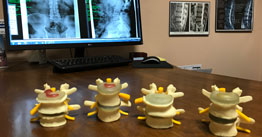Frequently Asked Questions
-
What causes back pain?
Back pain can be caused by a number of factors from poor posture & injuries to the effects of degenerative aging. The spinal cord is protected by the vertebrae, which are made of bone. Between each vertebra are soft discs with a fibrous outer layer. These spinal discs function as shock absorbers to protect the vertebra and the spinal cord. Many of the problems that cause back pain are the result of bulging and degeneration of the intervertebral disc. Degeneration is a process where wear and tear causes deterioration of the disc. Bulging of the disc are protrusions from the disc that press on surrounding nerves, causing pain, numbness or weakness.
-
Do I qualify for the DRX Spinal Decompression treatment?
Since our spinal center began using the DRX-9000 Non-Surgical Spinal Decompression Systems, we have been entertained with questions from both doctors and patients as to which cases it will best help. Obviously proper patient selection is essential to favorable outcomes. Since not everyone qualifies for DRX Spinal Decompression treatment, our qualification process is thorough and strict to achieve highest success for the qualified candidate.
-
Qualified DRX Candidate:
- Pain due to herniated and bulging lumbar or cervical discs that is more than four weeks old
- Recurrent pain from a failed back surgery that is more than six months old.
- Persistent pain from degenerated disc not responding to four weeks of therapy.
- Patients available for four weeks of treatment protocol.
- Patient at least 18 years of age.
-
Non-Qualified DRX Candidate:
- Appliances such as pedicle screws and rods
- Pregnancy
- Prior lumbar fusion less than six months old
- Metastatic cancer
- Severe osteoporosis
- Spondylolisthesis (unstable)
- Compression fracture of lumbar spine below L-1 (recent).
- Pars defect
- Pathologic aortic aneurysm.
- Pelvic or abdominal cancer
- Disc space infections
- Severe peripheral neuropathy
- Hemiplegia, paraplegia, or cognitive dysfunction
-
Who is a candidate for DRX Spinal Decompression?
Anyone who has been told they need surgery but wishes to avoid it, anyone who has been told there is nothing more available to help, anyone who failed to significantly respond to conservative options (medications, physical therapy, injections, chiropractic, acupuncture), or anyone who still has pain but wishes to obtain the type of care they want.
-
Are there any side effects to the treatment on the DRX Spinal Decompression?
Most patients do not experience any side effects. Though, there have been some mild cases of muscle spasm for a short period of time.
-
If I undergo DRX Spinal Decompression treatment, how long does it take to see results?
Most patients report a reduction in pain after the first few sessions. Typically, significant improvement is obtained by the second week of treatment.
-
How long does it take to complete DRX Spinal Decompression treatment?
Patients remain on the system for about 25-30 minutes, three times a week for the following 8 to 10 weeks.
-
How does DRX Spinal Decompression separate each vertebra and allow for decompression at a specific level?
Spinal Decompression is achieved by using a specific combination of spinal positioning and varying the degree and intensity of force. The key to producing this decompression is the gentle pull that is created by a logarithmic curve. When axial distractive forces are generated on a logarithmic curve the typical proprioceptor response is avoided. Avoiding this response allows decompression to occur at the targeted area.
-
How does DRX Spinal Decompression treatment differ from ordinary spinal traction?
Traction is helpful at treating some of the conditions resulting from herniated or degeneration. Traction cannot address the source of the problem. Spinal Decompression creates a negative pressure or a vacuum inside the disc. This effect causes the disc to pull in the herniation and the increase in negative pressure also causes the flow of blood and nutrients back into the disc allowing the body’s natural fibroblastic response to heal the injury and re-hydrate the disc. Traction and inversion tables, at best, can lower the intradiscal pressure from a +90 to a +30 mmHg. Spinal Decompression technology is clinically proven to reduce the intradiscal pressure to between a -150 to -200 mmHg. Traction triggers the body’s normal response to stretching by creating painful muscle spasms that worsen the pain in affected area.
-
Can DRX Spinal Decompression be used for patients that have had spinal surgery?
In most cases DRX Spinal Decompression treatment is not contra-indicated for patients that have had spinal surgery. In fact many patients have found success with Spinal Decompression after a failed back surgery.









